Key takeaways:
- World instruments carry cultural significance and can evoke deep emotional responses, creating connections among listeners.
- Cultural diversity in music fosters inclusivity and shared experiences, enriching the overall soundscape of events.
- Effective blending of genres and careful selection of instruments can elevate energy and create memorable atmospheres in nightclub settings.
- Incorporating storytelling elements through music deepens audience engagement, transforming events into communal experiences.
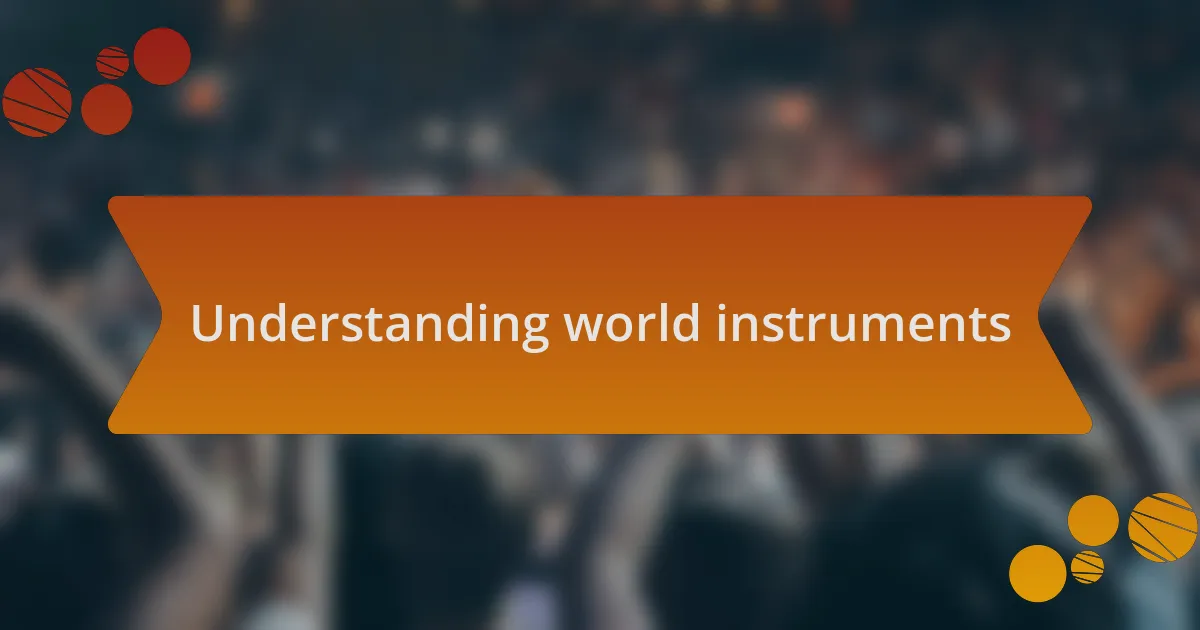
Understanding world instruments
World instruments are a fascinating tapestry of culture and history, each telling its own unique story. I remember the first time I heard a sitar in a small café; the intricate sounds transported me instantly to India, revealing the emotional depth of the music. How does a single instrument evoke such powerful feelings? It’s the connection between the melody and the traditions it carries that truly resonates with us.
Understanding these instruments goes beyond just their physical attributes; it’s about grasping the essence of their cultural significance. For instance, the djembe drum, with its vibrant rhythm, not only animates a gathering but also embodies the spirit and unity of African communities. This experience shaped my view on rhythm’s role in connecting people, making me wonder how many of us can identify a universal rhythm that touches our hearts.
I’ve found that when blending these world instruments into modern music environments, it’s essential to appreciate their origins. The airy tones of a bamboo flute can add a serene layer to an electronic track, reminding listeners of nature’s peace amidst a city’s chaos. Have you ever felt that juxtaposition? It’s like finding a hidden treasure in music, creating a bridge between different worlds and inviting everyone to explore.
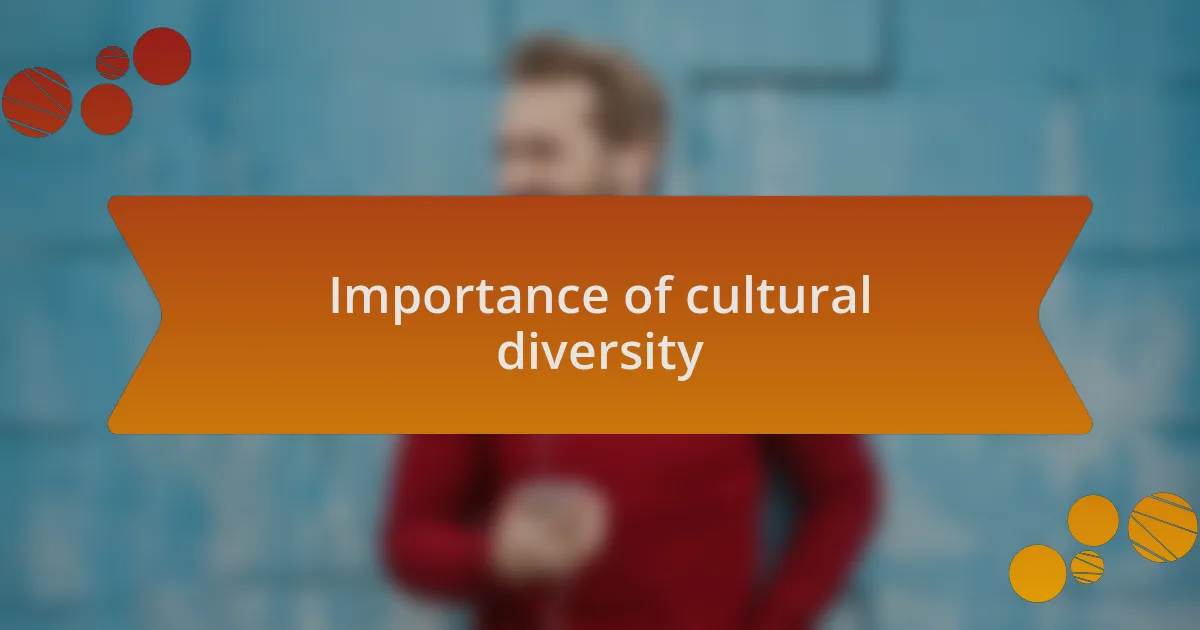
Importance of cultural diversity
Cultural diversity in music is not just about variety; it’s a vibrant dialogue between different traditions and communities. I recall a night at a rooftop party where a DJ seamlessly mixed Afrobeat with electronic music. The crowd, diverse in every sense, danced together, united by the infectious beats. Isn’t it amazing how music can dissolve barriers, creating a shared experience that transcends language and background?
In my journey through various musical landscapes, I’ve discovered that embracing cultural diversity enriches the soundscape of any venue. When I collaborated with musicians from different cultural backgrounds, each brought their unique essence to the mix. The result was a rich tapestry of sound that not only entertained but also educated our audience, opening their ears to new rhythms and melodies. Have you ever thought about how a simple song can teach you about another culture’s story?
The importance of cultural diversity cannot be overstated, especially in a nightclub setting. It’s vital to remember that incorporating instruments and styles from around the world fosters inclusivity among patrons. I once had the chance to host an event featuring a Brazilian samba band alongside a local hip-hop artist. The electric atmosphere was palpable—people from all walks of life came together, celebrating not just the music but also the shared human experience. It made me realize that when we embrace diversity, we create an environment where everyone feels they belong.
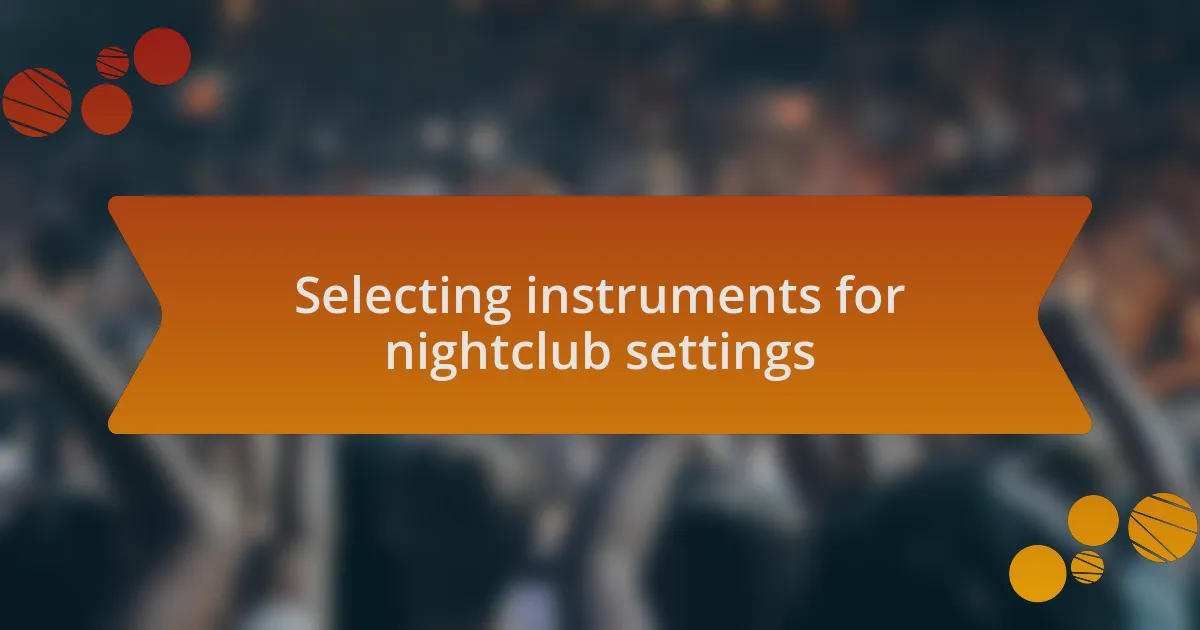
Selecting instruments for nightclub settings
Selecting instruments for a nightclub setting can be a transformative process. When considering the vibe of the evening, I often think about how certain instruments can elevate the energy in the room. For instance, introducing traditional drums from various cultures can add an infectious rhythm that encourages even the shyest dancers to hit the floor. Have you ever felt your body respond to that deep bass thump? It’s like a heartbeat connecting everyone.
I remember curating a special night where we featured a live sitar alongside our usual setup. The sound created an intriguing blend that drew in curious onlookers and dancers alike. People weren’t just listening—they were experiencing something new. The blend of unexpected elements can spark interest, and I’ve seen first-hand how this fusion fosters a deeper connection among the crowd.
Moreover, selecting instruments that resonate with the diverse backgrounds of your audience can turn a good night into a memorable one. I’ve seen the joy on people’s faces when they hear familiar sounds from their heritage woven into the music. It’s like a reminder of home, yet in the heart of a vibrant nightclub. How powerful is that connection when music becomes a bridge between past and present?
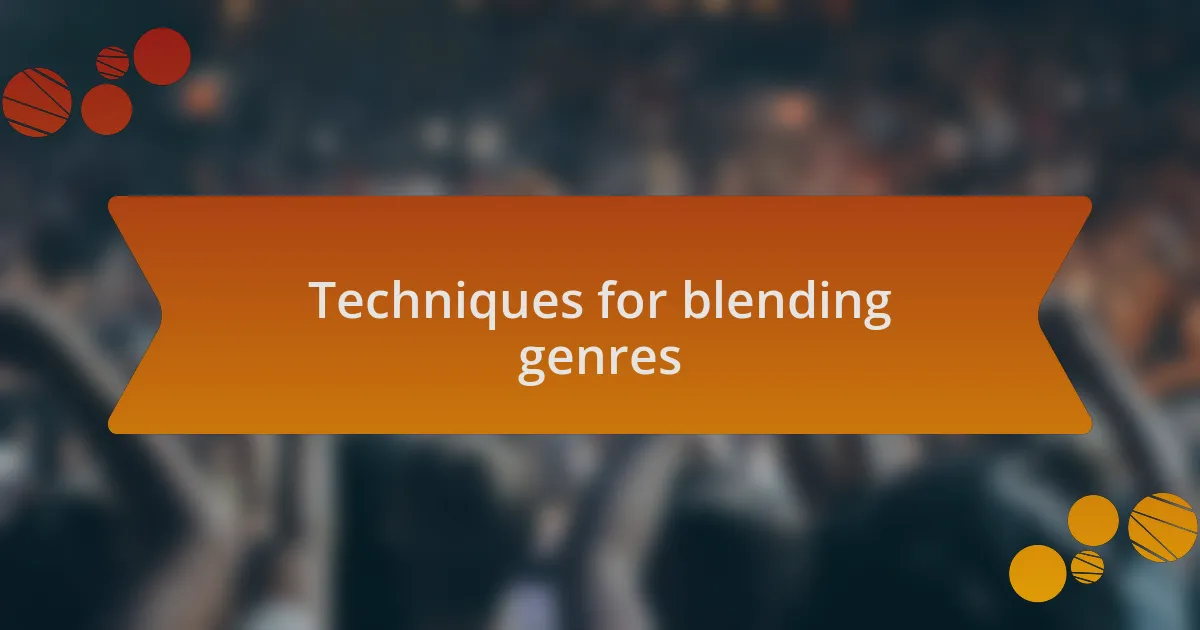
Techniques for blending genres
Blending genres involves more than just mixing sounds; it’s about creating a narrative that resonates with everyone present. I often find that layering different musical styles, like seamlessly integrating Latin rhythms with electronic beats, can craft a whole new atmosphere. Have you ever noticed how that slightest change in tempo or rhythm can transform the energy on the dance floor? It’s fascinating how a little experimentation can lead to an exhilarating night.
I vividly recall one event where I introduced a blend of reggae influences over a deep house foundation. The response was electric; people started swaying and vibing together in a way that made the room pulsate with life. This fusion not only caught attention but also sparked conversations among guests who might not have connected otherwise. It’s moments like these that illustrate the power of genre blending—turning a simple DJ set into a communal experience.
Another technique I employ is the use of unexpected transitions. A smooth shift from a classical violin piece to a heavy trap beat can leave the audience pleasantly surprised and fully engaged. In one instance, I paired a soulful saxophone solo with high-energy techno, and the crowd erupted into cheers. It’s in those unpredictable moments that I see unity among diverse groups, highlighting the potential of music to transcend boundaries. Isn’t it incredible how blending genres can transform the atmosphere and uplift spirits?
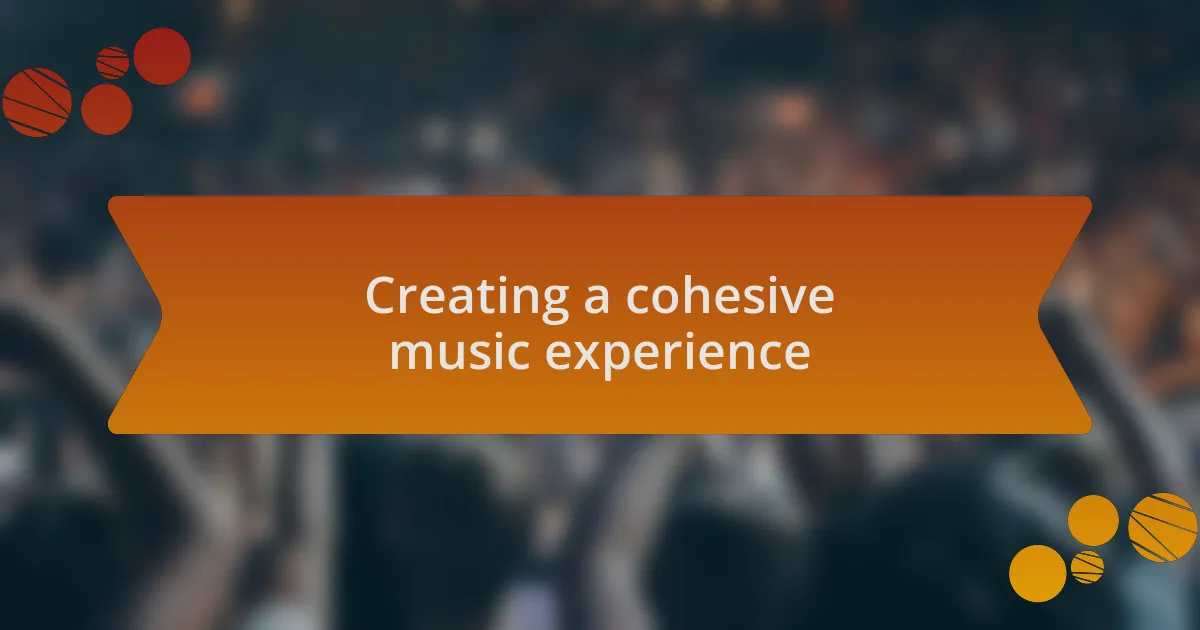
Creating a cohesive music experience
Creating a cohesive music experience requires an understanding of how each genre contributes to the overall vibe of the venue. I remember a night when I organized a themed event featuring global sounds—African drumming accompanied by electronic synths. The crowd felt connected, united by the rhythm that seemed to pulse through the very air. Have you ever noticed how the right combination can elevate the entire atmosphere? It’s almost like magic when everything aligns perfectly.
In my experience, transitions are essential for maintaining momentum throughout the night. During one set, I switched from an upbeat salsa tune to a smooth jazz instrumental, captivating the audience. This shift was deliberate, as I wanted to take them on a journey, allowing their minds to explore different cultures through sound. It’s these thoughtful choices that create a narrative, transforming each moment into something impactful and memorable.
Furthermore, incorporating storytelling elements through music can deepen the audience’s connection. I often share the origins of specific tracks or the artists behind them, creating a sense of intimacy and understanding. There was a particular night when I played a track inspired by traditional Indian music, explaining its cultural roots. The room fell silent as listeners absorbed the context, and then erupted into enthusiastic dance when the beat dropped. This shared journey enhances the experience, making it not just an event, but a collective memory woven into the fabric of the night.
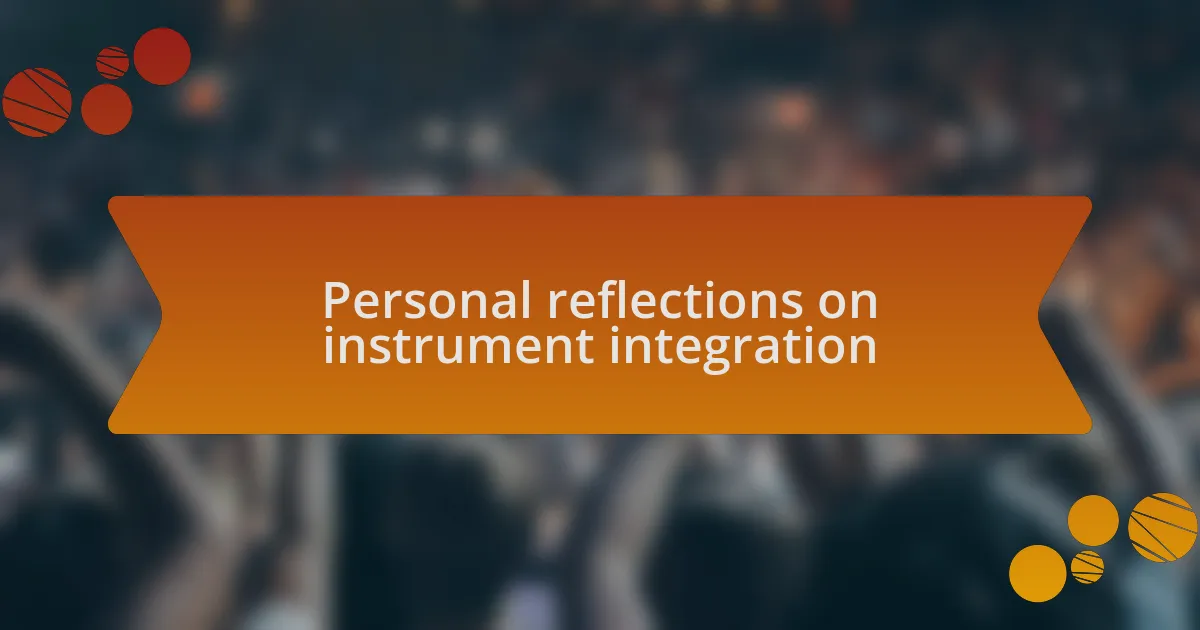
Personal reflections on instrument integration
When I think about instrument integration, one particular event comes to mind—the night I introduced a sitar alongside electronic dance beats. The euphoric response from the audience was astonishing; you could feel the energy shift as the unique sound of the sitar resonated with the crowd. It’s moments like these that make me realize how a single instrument can create a bridge between cultures and transform the night into something extraordinary.
I often ponder the emotional reactions that different instruments provoke. For instance, during a late-night set, I included didgeridoo sounds, and the atmosphere became instantly more meditative. I watched as people closed their eyes, swaying gently, seemingly lost in their own worlds. Have you experienced that powerful connection to music? It’s fascinating how the right instrument can evoke deep feelings, turning a fun night into something profoundly personal.
Incorporating world instruments isn’t just about diversity for me; it’s about storytelling through sound. I recall a night when I shared how a specific African rhythm symbolizes community and celebration. The way the audience engaged with that narrative made it clear they weren’t just passive listeners; they were active participants, eager to connect not only to the beat but also to the story behind it. This blend of education and entertainment creates a richer experience that lingers long after the music stops.

Successful examples from my venues
One night, I decided to combine the powerful rhythms of Afrobeat with the spirited sounds of a djembe. I vividly remember the crowd erupting into spontaneous dance, almost as if the music dictated their movements. Have you ever felt a moment where the beat just came alive around you? It was a reminder of how syncing genres can stir something primal within us, igniting a collective energy that’s simply unforgettable.
On another occasion, I integrated Celtic melodies played on the tin whistle into a more traditional house mix. The haunting notes contrasted beautifully with the heavier beats, creating a tapestry of sound that mesmerized my guests. I could see their expressions shift, each note pulling them deeper into the experience. It’s extraordinary how a simple instrument can resonate emotionally, allowing listeners to escape into a different world.
A particularly memorable night featured a pan flute, which I used to transition between tracks during a mellow set. The soft, airy sound blended seamlessly with the ambient lighting, and I watched as the intimate atmosphere drew people closer together. It’s those intimate moments that remind me of the power of music to connect hearts and create lasting memories. Have you ever had an experience where music brought people together in unexpected ways? For me, it’s those connections that truly highlight the magic of instrument integration.